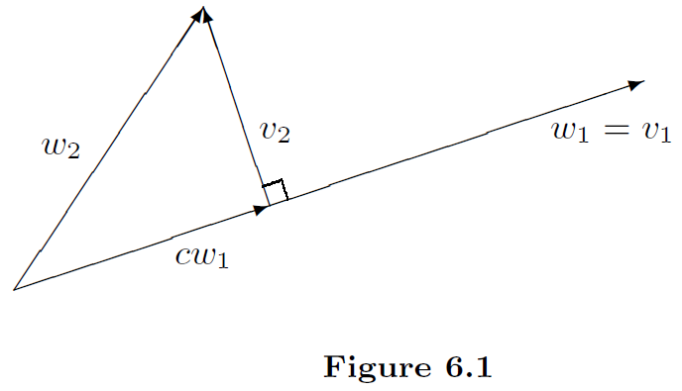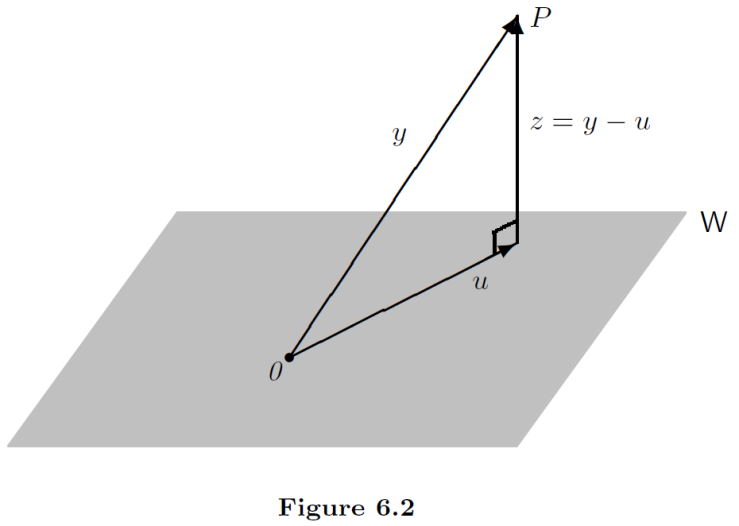6 Inner Products Spaces
6.1 Inner Products and Norms
Definition
Definition: Inner product [core]
Let
. for . where the bar denotes complex conjugation. if
Note that:
- The 3rd one reduces to
if - The 1st and 2nd parts simply require that the inner product be linear in the first component, (and conjugate linear in the second component).
- It's easily shown that if
and , then
The idea of distance or length is missing. Therefore we need a richer structure, the so-called inner product space structure, by adding a new inner product function.
Example 6.1.1
Example 1 For
The verification that
Thus, for
The inner product in Example 1 is called the standard inner product on
Example 6.1.2
If
Example 6.1.3
Let
- Since the proceding integral is linear in
, the 1st and the 2nd parts are immediate. - the 3rd one is trival (real-value).
- If
, then is bounded away from zero on some subinterval of (continuity is used here), and hence .
conjugate transpose
Definition: conjugate transpose
Let
Example 6.1.4
If
then
Notice that:
- if
are viewed as column vector in , then . - The conjugate transpose of a matrix plays a very important role in the remainder of this chapter. In the case that
has only real entries, is simply the transpose of .
Example 6.1.5
Let
Also
Now if
inner product space
The inner product on
A vector space
For the remainder of this chapter,
are inner products on the vector space
A very important inner product space that resembles
Show that the vector space
Check the condition one by one.
At this point, we mention a few facts about integration of complex-valued functions.
- the imaginary number
can be treated as a constant under the integration sign. - every complex-valued function
may be written as , where and are real-valued functions. Thus we have
Theorem 6.1
Let
. . . if and only if . - If
for all , then .
The 1st and 2nd of Theorem 6.1 show that the inner product is conjugate linear in the second component.
Norms
Definition: Norm / Length
Let
Example 6.1.6
Let
is the Euclidean definition of length. Note that if
Theorem 6.2
Theorem 6.2
Let
. if and only if . In any case, . - (Cauchy-Schwarz Inequality)
. - (Triangle Inequality)
.
Example 6.1.7
For
and
Orthogonal [core]
Definitions: orthogonal & orthonormal
Let
A subset
Note that if
Example 6.1.8
In
Example 6.1.9
Recall the inner product space
For what follows,
Now define
Also,
In other words,
6.2 The Gram-Schmidt Orthogonalization Process and Orthogonal Complements
Orthonormal basis
Definition: orthonormal basis
Let
Example 6.2.1
The standard ordered basis for
Example 6.2.2
The set
Theorem 6.3
Theorem 6.3
Let
where
Corollary of Theorem 6.3
Corollary
- If, in addition to the hypotheses of Theorem 6.3,
is orthonormal and , then
- Let
be an inner product space, and let be an orthogonal subset of consisting of nonzero vectors. Then is linearly independent.
For Corollary 1: If
Example 6.2.3
By Corollary 2, the orthonormal set
obtained in Example 6.1.8 is an orthonormal basis for
As a check, we have
Gram-Schmidt process
Before stating this theorem, let us consider a simple case. Suppose that

Figure 6.1 suggests that the set
So
Thus
Theorem 6.4: Gram-Schmidt process [core]
Let
Then
This construction of
Example 6.2.4 [core]
In
Take
Finally,
Normalization yields the orthonormal basis
Example 6.2.5
Let
and consider the subspace
Take
Furthermore,
Therefore
We conclude that
To obtain an orthonormal basis, we normalize
and similarly,
Thus
If we continue applying the Gram-Schmidt orthogonalization process to the basis
Theorem 6.5
Theorem 6.5
Let
Example 6.2.6
We use Theorem 6.5 to represent the polynomial
Therefore,
Corollary of Theorem 6.5
Corollary
Let
Fourier coefficients [core]
Definition: Fourier coefficients
Let
Example 6.2.7
Let
and for
Orthogonal complement
Definition: orthogonal complement
Let
The set
Example 6.2.8
The reader should verify that
Example 6.2.9
If
Let
We may think of
Consider the problem in
Determine the vector

Orthogonal projection
Theorem 6.6
Let
P.S. From Corollary 1 of Theorem 6.3:
Corollary
In the notation of Theorem 6.6, the vector
The vector
Example 6.2.10
Let
We compute the orthogonal projection
By Example 6.2.5,
Computing inner products:
Hence
Theorem 6.7
Theorem 6.7
Suppose that
can be extended to an orthonormal basis for . If
, then
is an orthonormal basis for
- If
is any subspace of , then
Example 6.2.11
Let
So